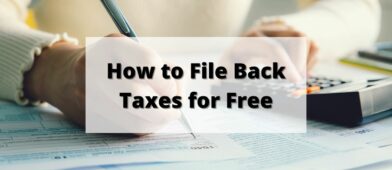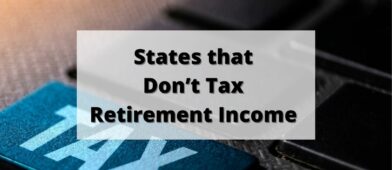The CARES Act became law on March 27, 2020, with several financial aid provisions for American households. Two signature pieces of the stimulus package are now arriving – stimulus checks and enhanced unemployment benefits.
As the unemployment rate continues to increase these benefits are more valuable than ever. Here’s what you need to know.
(and here is our master list of Coronavirus relief resources)
Table of Contents
- Stimulus Checks
- Who Qualifies?
- What if You Haven’t Filed Your 2019 Taxes Yet?
- How to Get Your Stimulus Payment
- Are These Economic Impact Payments Taxable?
- Are More Stimulus Checks Coming?
- Enhanced Unemployment Benefits
- How Long Do State Unemployment Insurance Benefits Last?
- Who Qualifies for Federal Unemployment Benefits?
- Do Self-Employed Workers Qualify for the Enhanced Federal Unemployment?
- How Long Can You Receive Federal Unemployment Insurance?
- Are the Federal Unemployment Benefits Taxable?
- Are More Federal Unemployment Benefits Coming?
- Stimulus Checks vs. Unemployment Insurance
Stimulus Checks
Most taxpayers are getting a one-time stimulus check in the coming weeks – if they haven’t received it already. The payment is up to $1,200 for individuals ($2,400 for joint tax returns) and $500 per dependant child.
A family of five can receive a one-time $3,900 payment, for instance.
Who Qualifies?
There are a few basic requirements to receive your stimulus payment:
- Have a Social Security number
- File a 2019 or 2018 federal tax return
- Non-filers may have to submit payment information
There isn’t a minimum earned income threshold to qualify for a payment. However, you can earn too much. Income phaseouts will result in reduced payment for higher adjusted gross incomes.
Single filers with income over $75,000 will have their stimulus check reduced by $5 for every $100 over $75,000. Single individuals with an income above $99,000 won’t receive any payment.
Joint filers begin seeing income phaseouts at $150,000, again with their check being reduced by $5 for every $100 earned above the limit. Joint filers become ineligible at $198,000.
Heads of household can receive a $1,200 payment plus $500 per child with an income up to $112,500. The upper phaseout limit depends on the number of children you have.
If you receive Social Security (SSI and SSDI) or Railroad Retirement benefits you qualify for the full amount.
What if You Haven’t Filed Your 2019 Taxes Yet?
Since the filing deadline for 2020 tax returns was pushed off until July many people have not filed their 2019 taxes yet. That’s ok. If you haven’t filed the government will use your income information from your 2018 taxes. (Income earned in 2018 and filed in 2019.)
If you qualify for the stimulus on your 2018 taxes you will receive a check. If you did not qualify based on your 2018 taxes but will qualify on your 2019 taxes you will receive your check after you file this year’s return.
But what if you did qualify on your 2018 taxes but will not qualify on your 2019 taxes? Will you owe the money back? No, you won’t. Therefore, if you know your 2019 tax return will disqualify you from receiving the stimulus you should wait until you receive it to file.
How to Get Your Stimulus Payment
Most people won’t have to do anything to receive their stimulus payment. You may need to take action if you’re a non-filer or need to update your direct deposit details on the IRS website. It’s also possible to update your mailing address using the IRS online tool.
- If you don’t need to file a tax return, and therefore did not file one for your 2018 or 2019 income check out this page from the IRS to see if you need to fill out their non-filers form.
- If you want to check the status of your payment you can do so here on the IRS website.
The IRS uses the bank account the IRS has on file for your 2019 federal tax return to direct deposit your payment. If you still need to file your 2019 tax return, the IRS uses your 2018 tax return instead.
The first batch of economic income payments went out the week of April 13, 2020. Most payments will be in taxpayers’ bank accounts before summer starts.
Expect to receive a paper check several weeks from now if the IRS doesn’t have your bank information. It may be early May before you the first paper checks go in the mail.
And don’t answer any phone calls or emails about your check – stimulus check scams are increasing as thieves look to prey on people’s stresses and needs. If you ever need to do anything, go to the IRS website directly.
Are These Economic Impact Payments Taxable?
No, the CARES Act economic impact payments are not taxable income. Since these stimulus payments are a “refundable tax credit,” meaning your total tax refund can be larger than your tax liability.
It doesn’t appear the IRS will require you to pay back a portion of your check if they overpay you. A prime example is if your 2020 taxable income falls within the income phaseouts but your 2019 income doesn’t.
Are More Stimulus Checks Coming?
House Democrats are promoting a second stimulus check with the Emergency Money for People Act. It too will be non-taxable income.
The follow-up stimulus check might be $2,000 monthly check for single adults age 16 or older ($4,000 for joint filers) for six months. Each child adds $500 per check, up to three children per family.
The income limits are also higher than the current one-time CARES Act stimulus check. Singles can have an income of up to $130,000 to receive the full payment. Joint filers get the full $4,000 monthly payment with an annual income of up to $260,000.
This proposal is still in the early stages and many changes can happen.
Enhanced Unemployment Benefits
Two programs were created to help those who have lost their incomes due to the pandemic.
- The CARES Act adds a $600 weekly benefit to those who were laid off from their W-2 jobs. You can read more about this here.
- The Pandemic Emergency Unemployment Compensation (PEUC) Program allows self-employed individuals who lost their income due to COVID to collect $600 per week in unemployment benefits. Typically, unemployment is not available to the self-employed.
Both worker classes will need to apply for benefits through the state unemployment website and will automatically receive enhanced federal benefits.
The additional $600 per week is in addition to any state benefits that someone may qualify for and is available through July 31, 2020. This will create a much more livable income for recipients since typically state unemployment benefits are quite small.
Here is more information about all the changes made to the unemployment program – Pandemic Emergency Unemployment Compensation (PEUC) Program.
How Long Do State Unemployment Insurance Benefits Last?
State-level unemployment insurance ends typically after 26 weeks, however, the CARES Act extends benefits an extra 13 weeks, for a total of 39 weeks.
Who Qualifies for Federal Unemployment Benefits?
Like the CARES Act stimulus check, many states have recently begun distributing the federal aid. Most adults already receiving state unemployment insurance can automatically receive the $600 weekly federal benefit until July 31, 2020.
If you’re newly unemployed, apply through your state unemployment insurance website.
The standard one-week waiting period doesn’t apply at the moment. You can apply as soon as you are officially laid off.
Do Self-Employed Workers Qualify for the Enhanced Federal Unemployment?
Normally, self-employed workers don’t qualify for unemployment insurance. However, the government made provisions to cover them during this time.
The PEUC extends the $600 weekly provision to freelancers and the self-employed who have lost their income due to the novel coronavirus pandemic.
It’s possible to claim these PUA benefits through December 31, 2020, for up to 39 weeks. However, you won’t qualify if you can telework from home with pay or are receiving another form of paid leave.
How Long Can You Receive Federal Unemployment Insurance?
The two different federal pandemic unemployment programs (CARES and PEUC) have different “sunset dates”.
Federal Pandemic Unemployment Compensation
The CARES Act lets qualified applicants receive weekly $600 federal benefits through July 31, 2020, with the Federal Pandemic Unemployed Compensation (i.e., W-2 employees).
Returning to work before that date means you no longer receive the federal benefit.
You can receive retroactive compensation from March 29, 2020, or when you become unemployed – whichever date is later.
Pandemic Unemployed Compensation
The Pandemic Unemployment Assistance program lets non-traditional employees (i.e., self-employed and part-time employees with limited hours) receive a $600 weekly benefit for up to 39 weeks through December 31, 2020.
The Pandemic Unemployment Assistance program for the self-employed and non-conventional workers can receive retroactive benefits starting January 27, 2020. Some businesses were already temporarily closing as soon as late January.
As this program doesn’t pair with state unemployment insurance, some states are slower to launch their PUA applications. But you will receive a retroactive benefit once your state agency approves your application.
Are the Federal Unemployment Benefits Taxable?
Yes, the IRS considers your $600 weekly federal unemployment benefit as taxable income. Any state unemployment insurance benefits you receive are taxable as well. Your state may also consider the benefits as taxable income.
Your state may give you the option to withhold the income taxes upfront. Expect to have 10% of your benefits withheld for federal income tax plus any state withholdings. Paying the tax upfront minimizes the likelihood of a surprise tax bill when filing your taxes.
Not withholding upfront means you are responsible for paying income tax when you file your return. Deferring can be the better option if you need every dollar now to buy essential items.
Your state unemployment agency furnishes a Form 1099-G to report unemployment benefits at tax time.
Are More Federal Unemployment Benefits Coming?
It’s still too soon to tell if lawmakers will extend the federal unemployment benefits. The answer depends on how soon companies call workers back.
During the 2009 Great Recession, unemployment benefits extended up to 99 weeks in many states. The average state unemployment insurance benefits were up to 26 weeks before the Great Recession as well.
Stimulus Checks vs. Unemployment Insurance
Let’s do a quick review of the key features of these two stimulus measures.
Stimulus Checks
- One-time payment
- Must file a 2019 (or 2018) federal tax return
- Pension and disability beneficiaries can receive a full payment
- Singles get up to $1,200 ($2,400 for joint filers)
- Each dependant child adds $500 to the economic impact payment amount
- The entire payment is tax-free
- Advanced tax credit for your 2020 adjusted gross income
- May receive additional credit if you add dependents or marry in 2020
- Can receive a credit if your 2019 income was too high but your 2020 income isn’t
Federal Unemployment Benefits
- Must lose job for a qualifying reason to qualify
- Must apply through your state unemployment insurance agency
- Weekly $600 benefit plus state unemployment benefits
- Benefits can apply retroactively to March 29, 2020, or date of job loss – the later date
- Most applicants can receive $600 weekly benefit through July 31, 2020
- Self-employed and others can also qualify for a weekly $600 benefit
- State unemployment insurance extended from 26 weeks to 39 weeks
- All federal benefits are taxable income
Both of these benefits address different financial needs. The one-time stimulus check can pay essential bills and offset reduced wages. If you’re still gainfully employed, you might decide to save or invest the stimulus payment instead.
The enhanced unemployment benefits can reduce the financial and mental stress that comes from temporary unemployment. While these benefits are taxable, many households can continue to buy weekly staples after using the stimulus check.




Kimberly postlethwait says
when should people who do not have a bank account or did not file income tax for 2018 and 2019 receive thete stemulis check?
If you didn’t file and you aren’t on Social Security, you need to fill out the nonfilers payment form.
Laurie King says
If you’re getting the extra $600 on the unemployment check, do you still qualify for a stimulus check?
Yes, unemployment benefits and stimulus are unrelated – the stimulus is based on your 2019 or 2018 tax return.
Fred Wallcott says
I just signed up for my UI benefits and the last question is if you received any payments like 401k or anythting. I did get my stimulus and now I dont know if I need to say yes I got 1200 bucks and will they not pay me my UI because of the deposited stimulus? I thought stimulus was supposed to be completely separate but I dont want to get in trouble if im in error for not reporting it and I dont want to lose it if I didnt need to report it. So confusing trying to do the right thing.
What state are you in? You can get the stimulus and UI benefits at the same time, they (PUA) were written into the same bill. I think they’re trying to identify other sources of income.
Jeff Shaw says
Jim, I’m from Ohio and self-employed. When I filed my initial PUA claim, I declared zero earnings for the first two weeks. I got my first lump sum for several backdated claims and they automatically entered my $1200 stimulus check under “earnings” so I received $0 benefits for that first week.
Lala says
Do we still get the stimulus check even if we get unemployment?
Yes, they’re unrelated (in terms of who gets them).
Dominic says
I have been on unemployment as of March and didn’t qualify for the 1st round of stimulus checks due to my salary in 2019. But since i have now lost my employment will i qualify for the stimulus check now that i have lost my employment? How are they going to go off last year’s salary if you don’t have employment this year and fail to receive the stimulus check due to your salary from last year? How does that work out?
It will depend on the language of the bill but if it’s identical to Cares 1, they won’t know. You would only get the check after you file your taxes next year.
Randal R Clyde says
I’m in Mn. I just signed up for unemployment and received my 1st benefit payment and also my $1200 stimulus check. Do have to report it to unemployment as income? Thanks
The stimulus check is not income, it’s an advance on a refundable tax credit.
Steve says
My unemployment checks stopped at the end of September.I am told to apply for three jobs each week in order to continue to be paid .Will I be paid the weekly stimulus checks if I don’t apply for three jobs a week ?
You’ll have to check with your state’s unemployment department to know for sure.